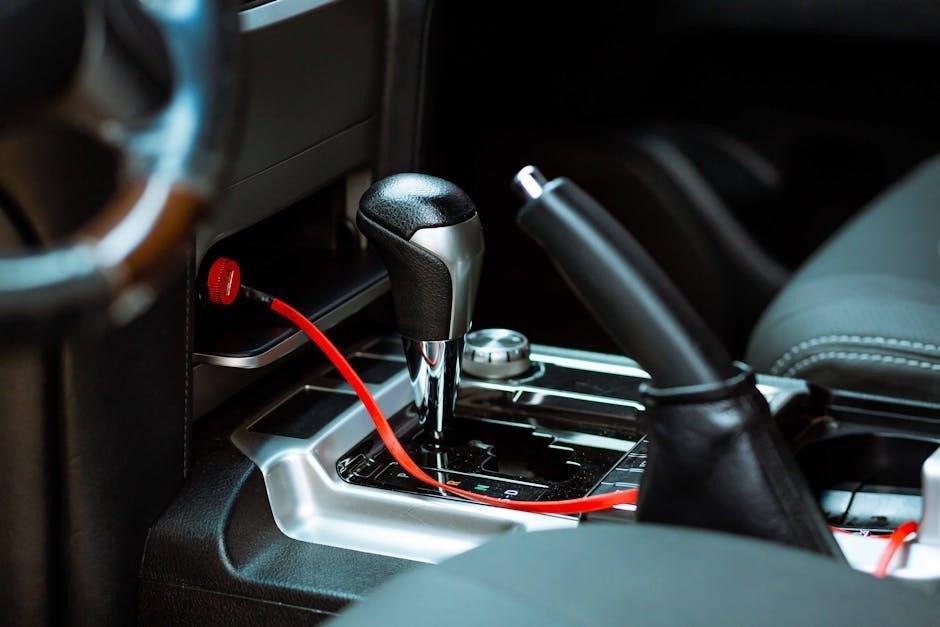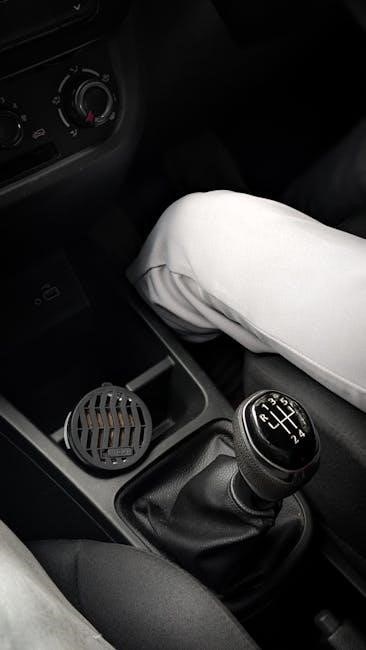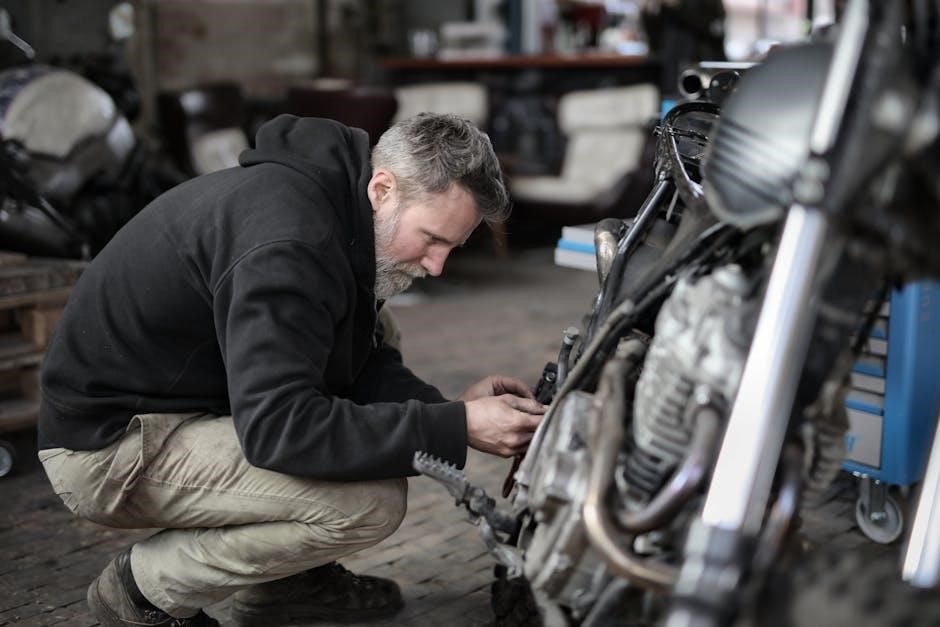manual transmission problems

manual transmission problems
A manual transmission, also known as a stick shift, is a gearbox that requires driver interaction to change gears. It remains popular for its control, fuel efficiency, and driving engagement. Understanding its components and troubleshooting common issues is essential for maintaining performance and preventing costly repairs.
1.1 What is a Manual Transmission?
A manual transmission is a type of gearbox that requires the driver to manually change gears using a clutch pedal and a shift lever. It consists of gears, bearings, and synchronizers, allowing the driver to control torque and speed. Unlike automatic transmissions, manual transmissions rely on the driver’s input to engage and disengage gears, providing better control and fuel efficiency. Understanding its operation is key to identifying and addressing common issues.
1.2 Importance of Manual Transmissions in Vehicles
Manual transmissions are valued for their fuel efficiency, lower maintenance costs, and enhanced driver control. They are often preferred in performance and racing applications due to faster gear shifts. Additionally, manual transmissions are less complex than automatics, reducing the risk of major mechanical failures. Their durability and simplicity make them a popular choice for drivers seeking a more engaging and cost-effective driving experience.

Common Manual Transmission Problems
Manual transmissions often face issues like slipping clutches, gear shifting difficulties, sticking clutches, and leaking or dirty transmission fluid, which can disrupt smooth vehicle operation and performance.
2.1 Slipping Clutch
A slipping clutch is a common issue where the clutch fails to engage properly, causing gears to slip and poor acceleration. It often results from worn clutch components, improper clutch release, or insufficient transmission fluid. Symptoms include difficulty shifting gears and a spongy pedal feel. If left untreated, it can lead to further damage, emphasizing the need for early diagnosis and repair to maintain smooth transmission functionality.
2.2 Gear Shifting Problems
Gear shifting issues often arise due to worn synchronizers, faulty linkages, or insufficient lubrication. Symptoms include difficulty engaging gears, grinding, or the transmission popping out of gear. These problems can be exacerbated by abusive driving habits or lack of maintenance. Regular checks of transmission fluid and linkage adjustments can help prevent such issues, ensuring smoother gear transitions and overall transmission longevity.
2.3 Sticking Clutch
A sticking clutch occurs when the clutch fails to disengage fully, causing unintended gear engagement. This is often due to warped or glazed clutch plates, faulty master or slave cylinders, or hydraulic system issues. Symptoms include difficulty shifting gears and jerky acceleration; Addressing this promptly is crucial to prevent further damage to the clutch and transmission components, ensuring smooth operation and extending the system’s lifespan.
2.4 Leaking or Dirty Transmission Fluid
Leaking or dirty transmission fluid is a common issue that can lead to manual transmission problems. Causes include worn seals, damaged gaskets, or a cracked pan. Symptoms may involve fluid spots under the vehicle and hesitation during gear shifts. Regular fluid checks and timely repairs are essential to prevent further damage and ensure smooth transmission operation and longevity of the system components.

Gear-Related Issues
Manual transmissions often face gear-related problems like grinding or slipping gears. These issues stem from worn synchronizers, improper clutch engagement, or misaligned gears, requiring prompt repair.
3.1 Grinding Gears
Grinding gears in a manual transmission occur when gears clash due to improper synchronization or clutch release. This can damage gear teeth and bearings. Causes include worn-out synchronizers, incorrect clutch pedal use, or misaligned gear components. Addressing this issue promptly is crucial to prevent further damage and costly repairs. Regular maintenance and proper driving techniques can help avoid this problem.
3.2 Slipping Gears
Gear slipping in a manual transmission happens when gears fail to engage properly, causing unintended shifts. This can result from worn clutch facings, low transmission fluid levels, or damaged gear teeth. If left unaddressed, it may lead to complete gear failure. Regular inspection of clutch and transmission components is essential to prevent slipping and ensure smooth gear engagement during driving.

Transmission Fluid and Lubrication
Transmission fluid lubricates gears and bearings, preventing friction and overheating. Proper levels and quality ensure smooth operation. Neglecting fluid maintenance can lead to premature wear and system failure.
4.1 Effects of Dirty or Leaking Transmission Fluid
Dirty or leaking transmission fluid can cause gears to grind, slip, or overheat, leading to costly repairs. It may also result in erratic shifting, clutch failure, and reduced fuel efficiency. Regular fluid checks and replacements are essential to maintain smooth operation and prevent premature wear of critical components in the manual transmission system.
4.2 Importance of Proper Lubrication
Proper lubrication is crucial for smooth gear transitions and preventing wear on moving parts. It reduces friction, prevents overheating, and extends the lifespan of the transmission. Using the correct type and amount of fluid ensures optimal performance and avoids costly repairs. Regular fluid changes and checks are essential to maintain the health and efficiency of the manual transmission system.

Clutch Pedal Problems
Clutch pedal issues, such as a spongy feel or failure to return, often indicate problems with the master cylinder, slave cylinder, or hydraulic system. Addressing these promptly prevents further damage.
5.1 Clutch Pedal Not Returning Properly
A clutch pedal that fails to return to its normal position can disrupt smooth gear transitions. This issue often arises from air in the hydraulic system, a faulty slave or master cylinder, or fluid leaks. If left unchecked, it can lead to incomplete gear engagement and potential damage to the transmission. Bleeding the hydraulic system or replacing faulty components may resolve the issue.
5.2 Spongy or Soft Clutch Pedal
A spongy or soft clutch pedal indicates a problem with the hydraulic system. Air in the system or low fluid levels often cause this issue, leading to inconsistent pedal feel. If left unaddressed, it can result in incomplete clutch disengagement, causing the clutch to drag. Bleeding the hydraulic system and ensuring proper fluid levels typically resolve the issue, restoring firm pedal operation.

Hard Shifting and Noisy Transmission
Hard shifting and noise often result from worn synchronizers, low transmission fluid levels, or damaged bearings. These issues can lead to poor gear engagement and operational discomfort.
6.1 Causes of Hard Shifting
Hard shifting in manual transmissions is often due to worn or damaged synchronizers, which fail to engage gears smoothly. Additionally, insufficient or degraded transmission fluid can cause friction, leading to difficulty in shifting. Other contributing factors include misaligned gears, faulty clutch operation, or issues with the shift linkage, all of which can disrupt the mechanical harmony of the system.
6.2 Noisy Transmission Symptoms
Noisy transmission symptoms include whining, howling, or grinding sounds during operation. These noises often indicate worn gears, bearings, or shafts. Whining may suggest insufficient lubrication or damaged gear teeth, while grinding could signal misaligned gears or worn synchronizers. Rumbling sounds during acceleration may point to faulty bearings or shafts. Ignoring these noises can lead to further damage, requiring costly repairs.

Transmission Fluid Leaks
Transmission fluid leaks are common issues caused by worn seals, damaged gaskets, or loose bolts. They can lead to lubrication loss, overheating, and eventual gearbox failure if untreated.
7.1 Identifying Transmission Fluid Leaks
Identifying transmission fluid leaks involves inspecting the gearbox for signs of seepage, particularly around seals and gaskets. Look for reddish-brown stains or puddles under the vehicle. Check the fluid level regularly and monitor for drops. Loose bolts or damaged pan gaskets are common culprits. Addressing leaks promptly prevents major damage and costly repairs.
7.2 Consequences of Untreated Leaks
Untreated transmission fluid leaks can lead to severe complications, including lubrication failure, overheating, and accelerated wear on gears and bearings. Prolonged neglect may result in complete gearbox failure, requiring an expensive overhaul or replacement. Regular maintenance and prompt repairs are crucial to prevent such outcomes and ensure optimal transmission performance and longevity.

Clutch and Gear Engagement Issues
Clutch and gear engagement problems often stem from worn components or improper alignment, leading to slippage, difficulty shifting, and reduced vehicle control. Addressing these issues promptly prevents further damage.
8.1 Trouble Staying in Gear
Trouble staying in gear often arises from worn synchronizers, damaged gear teeth, or a failing clutch. These issues can cause gears to slip or disengage unexpectedly, leading to loss of control. Regular maintenance and prompt repairs are crucial to prevent further damage and ensure safe driving conditions. Addressing these problems early is essential for maintaining transmission longevity.
8.2 Dragging Clutch
A dragging clutch occurs when the clutch fails to fully disengage, causing the engine to stall or struggle during gear shifts. Common causes include misaligned linkage, worn clutch components, or improper clutch master cylinder function. Symptoms often manifest as difficulty shifting gears or the vehicle stalling when attempting to change gears. Addressing this issue promptly prevents further damage and ensures smooth operation.

Less Common But Serious Problems
Less common issues include gear popping, double engagement, and faulty torque converters or sensors, which can lead to severe damage if not addressed promptly by professionals.
9.1 Gear Popping Out (Jumping Gears)
Gear popping, or jumping gears, occurs when gears disengage unintentionally, often due to a damaged clutch, worn synchronizers, or loose linkage. This can lead to loss of control and potential gearbox damage. Regular inspection of clutch components, synchronizers, and linkages is crucial. Addressing the issue promptly prevents costly overhauls and ensures smooth transmission operation.
9.2 Double Engagement or Gear Selection Issues
Double engagement occurs when two gears are partially engaged, causing grinding or difficulty shifting. This is often due to worn-out synchronizers, misaligned gear teeth, or improper clutch release. Immediate attention is necessary to prevent gear damage. Replacing synchronizers, adjusting the clutch, and ensuring proper alignment can resolve this issue and restore smooth gear transitions.

Troubleshooting and Solutions
Troubleshooting manual transmission issues involves identifying symptoms like grinding gears or slipping clutches. Solutions often include fluid changes, repairing damaged components, and professional servicing. Regular maintenance, such as replacing worn synchronizers and seals, can prevent major problems. Addressing issues promptly ensures smooth performance and extends the transmission’s lifespan, saving time and money in the long run.
10.1 DIY Troubleshooting Steps
Begin by checking the transmission fluid level and condition, as low or dirty fluid can cause slipping or grinding gears. Inspect the clutch pedal for proper alignment and function. If gears clash or slip, worn synchronizers or improper clutch release may be the issue. Replacing filters and seals can resolve leaks, while adjusting shift linkages can improve gear engagement. Regular fluid changes and thorough inspections help prevent major repairs, ensuring smooth operation and prolonging transmission life by addressing issues early and effectively through these simple, cost-saving DIY steps.
10.2 When to Seek Professional Help
If you encounter severe issues like gears grinding or slipping persistently, it’s crucial to consult a professional mechanic. Problems like a failed clutch master cylinder or broken linkage wire require specialized tools and expertise. Similarly, if fluid leaks or unusual noises worsen, professional intervention is necessary to prevent further damage. Experts can diagnose complex issues accurately and perform repairs efficiently, ensuring your transmission operates smoothly and safely on the road, avoiding costly breakdowns and prolonging its lifespan effectively.